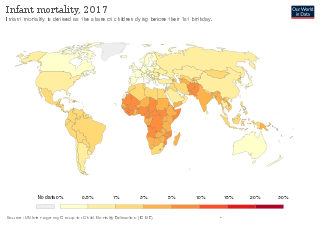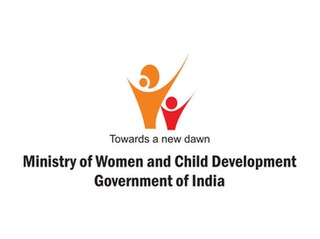| Integrated Child Development Services | |
|---|---|
| Country | India |
| Launched | 2 October 1975 |
Integrated Child Development Services (ICDS) is a government program in India which provides nutritional meals, preschool education, primary healthcare, immunization, health check-up and referral services to children under 6 years of age and their mothers. [1] The scheme was launched in 1975, discontinued in 1978 by the government of Morarji Desai, and then relaunched by the Tenth Five Year Plan.
Tenth five-year plan also linked ICDS to Anganwadi centres established mainly in rural areas and staffed with frontline workers. [2] In addition to improving child nutrition and immunization, the programme is also intended to combat gender inequality by providing girls the same resources as boys.
A 2005 study found that the ICDS programme was not particularly effective in reducing malnutrition, largely because of implementation problems and because the poorest states had received the least coverage and funding. [2] During the 2018–19 fiscal year, the Indian federal government allocated ₹16,335 crore (US$2.0 billion) to the programme, which is 60% of the funding for the programme while the states allocated the remaining 40%. [3] The widespread network of ICDS has an important role in combating malnutrition especially for children of weaker groups. [4]
The infant mortality rate of Indian children is 34% [5] and the under-five mortality rate is 39% [6] and 25% of newborn children are underweight among other nutritional, immunization and educational deficiencies of children in India. Figures for India are below the standards of the developed world. [7]
ICDS was launched in 1975 [1] in accordance to the National Policy for Children in India. [8] Over the years it has grown into one of the largest integrated family and community welfare schemes in the world. [7] Given its effectiveness over the last few decades, Government of India has committed towards ensuring universal availability of the programme. [9]
The following services are sponsored under ICDS to help achieve its objectives: [10]
For nutritional purposes ICDS provides 500 kilocalories (with 12–15 grams of protein) every day to every child from 6 months to 6 years of age. [11] For adolescent girls in the age group of 10 to 19, 6 kilograms of food grain is given every months.[ citation needed ]
The services of Immunisation, Health Check-up and Referral Services delivered through Public Health Infrastructure under the Ministry of Health and Family Welfare. [1] UNICEF has provided essential supplies for the ICDS scheme since 1975. [10] World Bank has also assisted with the financial and technical support for the programme. [9] The cost of ICDS programme averages $10–$22 per child a year. [9] The scheme is Centrally sponsored with the state governments contributing up to ₹1.00 (1.3¢ US) per day per child. [11]
Furthermore, in 2008, the GOI adopted the World Health Organization standards for measuring and monitoring the child growth and development, both for the ICDS and the National Rural Health Mission (NRHM). [1] These standards were developed by WHO through an intensive study of six developing countries since 1997. [1] They are known as New WHO Child Growth Standard and measure of physical growth, nutritional status and motor development of children from birth to 5 years age. [12]
Despite increasing funding over the past three decades, the ICDS fell short of its stated objectives and still faces a number of challenges. Also, though it has widespread coverage, operational gaps mean that service delivery is not consistent in quality and quantity across the country. [13]
By end of 2010, the programme is claiming to reach 80.6 lakh expectant and lactating mothers along with 3.93 crore children (under 6 years of age). [10] There are 6,719 operational projects with 1,241,749 operational Aanganwadi centres. [1] Several positive benefits of the programme have been documented and reported
However, World Bank has also highlighted certain key shortcomings of the programme including inability to target the girl child improvements, participation of wealthier and middle-class children more than low-income children and lowest level of funding for the poorest and the most undernourished states of India. [19]

Infant mortality is the death of an infant before the infant's first birthday. The occurrence of infant mortality in a population can be described by the infant mortality rate (IMR), which is the number of deaths of infants under one year of age per 1,000 live births. Similarly, the child mortality rate, also known as the under-five mortality rate, compares the death rate of children up to the age of five.
The United Nations World Summit for Children was held in the United Nations Headquarters in New York City on 29–30 September 1990. The summit had the then-largest-ever gathering of heads of state and government to commit to a set of goals to improve the well-being of children worldwide by the year 2000. It was the first time a UN conference had set a broad agenda for a wide range of goals in health, education, nutrition and human rights.

India's population in 2021 as per World Bank is 1.39 billion. Being the world's second-most-populous country and one of its fastest-growing economies, India experiences both challenges and opportunities in context of public health. India is a hub for pharmaceutical and biotechnology industries; world-class scientists, clinical trials and hospitals yet country faces daunting public health challenges like child undernutrition, high rates of neonatal and maternal mortality, growth in noncommunicable diseases, high rates of road traffic accidents and other health related issues.

Child mortality is the mortality of children under the age of five. The child mortality rate refers to the probability of dying between birth and exactly five years of age expressed per 1,000 live births.

An Anganwadi is a type of rural child care centre in India. They were started by the Indian government in 1975 as part of the Integrated Child Development Services program to combat child hunger and malnutrition. Anganwadi in Hindi means "courtyard shelter" in English.
Health care services in Nepal are provided by both public and private sectors and are generally regarded as failing to meet international standards. Prevalence of disease is significantly higher in Nepal than in other South Asian countries, especially in rural areas. Moreover, the country's topographical and sociological diversity results in periodic epidemics of infectious diseases, epizootics and natural hazards such as floods, forest fires, landslides, and earthquakes. But, recent surge in Non communicable diseases has emerged as the main public health concern and this accounts for more than two-thirds of total mortality in country. A large section of the population, particularly those living in rural poverty, are at risk of infection and mortality by communicable diseases, malnutrition and other health-related events. Nevertheless, some improvements in health care can be witnessed; most notably, there has been significant improvement in the field of maternal health. These improvements include:

The Ministry of Women and Child Development, a branch of the Government of India, is an apex body for formulation and administration of the rules and regulations and laws relating to women and child development in India. The current minister for the Ministry of Women and Child Development is Smriti Irani having held the portfolio since 31 May 2019.
Despite India's 50% increase in GDP since 2013, more than one third of the world's malnourished children live in India. Among these, half of the children under three years old are underweight.

The National Health Mission (NHM) was launched by the government of India in 2005 subsuming the National Rural Health Mission and National Urban Health Mission. It was further extended in March 2018, to continue until March 2020. It is headed by Mission Director and monitored by National Level Monitors appointed by the Government of India.Rural Health Mission (NRHM) and the recently launched National Urban Health Mission (NUHM). Main program components include Health System Strengthening (RMNCH+A) in rural and urban areas- Reproductive-Maternal- Neonatal-Child and Adolescent Health, and Communicable and Non-Communicable Diseases. NHM envisages achievement of universal access to equitable, affordable and quality health care services that are accountable and responsive to the needs of the people.

Coluthur Gopalan FRCP, FRS, FAMS, FASc was an Indian nutritionist. He was responsible for initiating nutrition research in independent India, leading to a number of interventions such as the Integrated Child Development Services, the midday meal scheme for school children, goiter prevention programme, etc. The burning feet syndrome is also known as Grierson-Gopalan syndrome. While the condition was described in 1826 by a British medical officer James Grierson, Gopalan also described this condition in 1946 when he observed it, "chiefly in females between the ages of 20 and 40 years, among the poor in South India".
The health care system in Kolkata consists of 48 government hospitals, mostly under the Department of Health & Family Welfare, Government of West Bengal, and 366 private medical establishments during 2010.
Universal Immunisation Programme (UIP) is a vaccination programme launched by the Government of India in 1985. It became a part of Child Survival and Safe Motherhood Programme in 1992 and is currently one of the key areas under the National Health Mission since 2005. The programme now consists of vaccination for 12 diseases- tuberculosis, diphtheria, pertussis, tetanus, poliomyelitis, measles, hepatitis B, rotaviral gastroenteritis, Japanese encephalitis, rubella, pneumonia and Pneumococcal diseases. Hepatitis B and Pneumococcal diseases were added to the UIP in 2007 and 2017 respectively. The cost of all the vaccines are borne entirely by the Government of India and is funded through taxes with a budget of ₹7,234 crore (US$910 million) in 2022 and the program covers all residents of India, including foreign residents.
Malnutrition continues to be a problem in the Republic of South Africa, although it is not as common as in other countries of Sub-Saharan Africa.
Under Article 15(3), the Constitution of India allows for positive discrimination in favor of women. The article, under right to equality, states that: "Nothing in this article shall prevent the State from making any special provision for women and children." In addition, the Directive Principles of State Policy 39(A) states that: "The State shall, in particular, direct its policy towards securing that the citizens, men and women equally, have the right to an adequate means of livelihood."
Both maternal and child health are interdependent and substantially contributing to high burden of mortality worldwide. Every year, 289 000 women die due to complications in pregnancy and childbirth, and 6.6 million children below 5 years of age die of complications in the newborn period and of common childhood diseases. Sub-Saharan Africa (SSA), which includes Tanzania, contribute higher proportion of maternal and child mortality. Due to considerable proportion of mortality being attributed by maternal and child health, the United Nations together with other international agencies incorporated the two into Millennium Development Goals (MDGs) 4 and 5. In this regard, Tanzania through the Ministry of Health and Social Welfare (MoHSW) adopted different strategies and efforts to promote safe motherhood and improve child survival. Similarly, in an effort to improve maternal and child health, Tanzania's government has declared maternal and child health services to be exempt from user fees in government facilities.
Malnutrition is a condition that affects bodily capacities of an individual, including growth, pregnancy, lactation, resistance to illness, and cognitive and physical development. Malnutrition is commonly used in reference to undernourishment, or a condition in which an individual's diet does not include sufficient calories and proteins to sustain physiological needs, but it also includes overnourishment, or the consumption of excess calories.

Undernutrition in children, occurs when children do not consume enough calories, protein, or micronutrients to maintain good health. It is common globally and may result in both short and long term irreversible adverse health outcomes. Undernutrition is sometimes used synonymously with malnutrition, however, malnutrition could mean both undernutrition or overnutrition. The World Health Organization (WHO) estimates that malnutrition accounts for 54 percent of child mortality worldwide, which is about 1 million children. Another estimate, also by WHO, states that childhood underweight is the cause for about 35% of all deaths of children under the age of five worldwide.
Child health and nutrition in Africa is concerned with the health care of children through adolescents in the various countries of Africa. The right to health and a nutritious and sufficient diet are internationally recognized fundamental human rights protected by international treaties and conventions on the right to life, as well as in charters, strategies and declarations. Millennium Development Goals (MDGs) 1, 4, 5 and 6 highlight, respectively, how poverty, hunger, child mortality, maternal health, the eradication of HIV/AIDS, malaria, tuberculosis and other diseases are of particular significance in the context of child health.

India is the second most populated country in the world with nearly a fifth of the world's population. According to the 2022 revision of the World Population Prospects the population stood at 1,407,563,842.